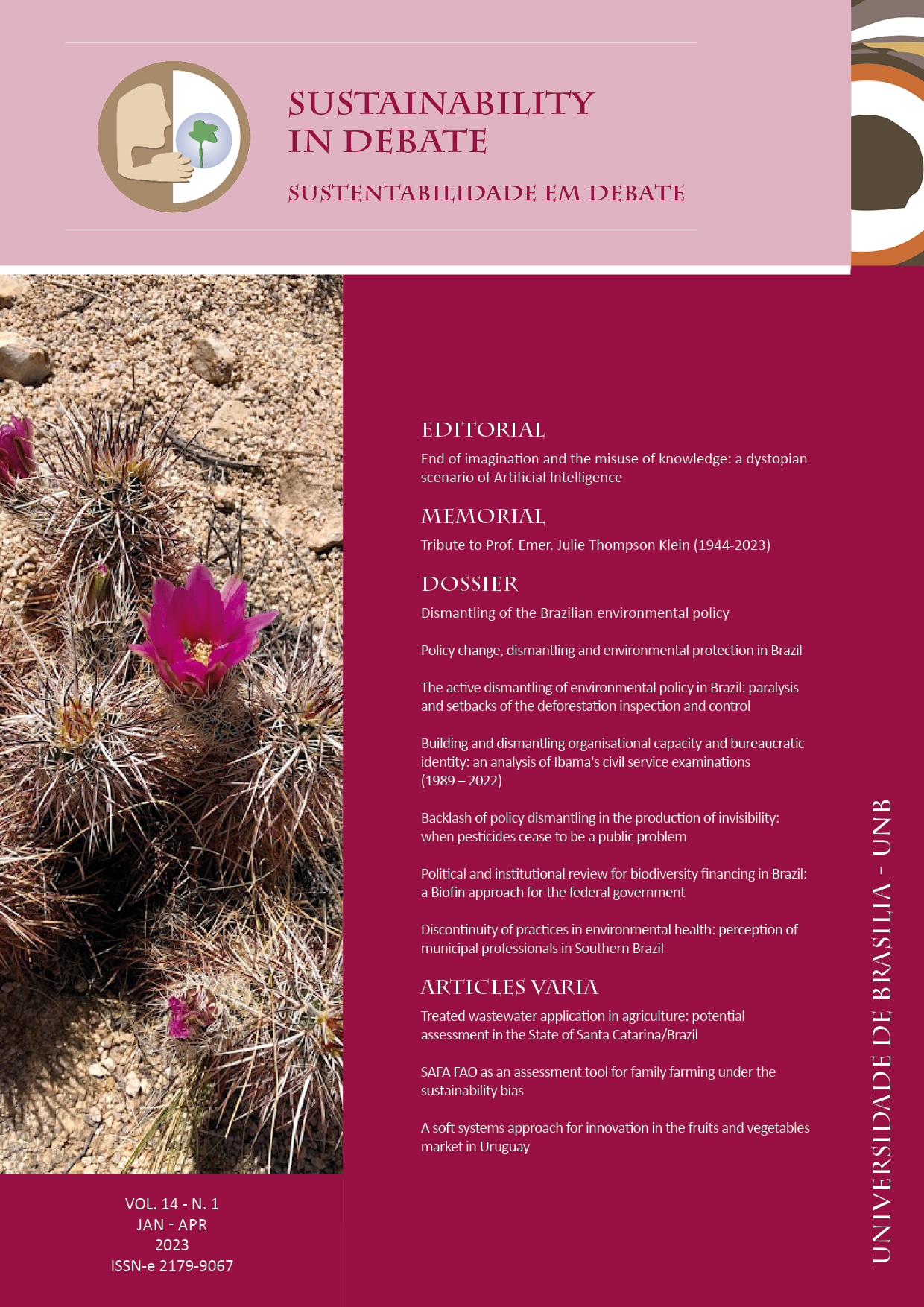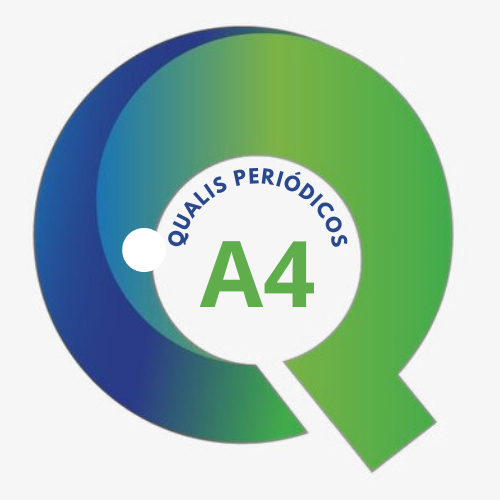Aplicação de esgoto tratado na agricultura: avaliação de potencial no Estado de Santa Catarina/Brasil
DOI:
https://doi.org/10.18472/SustDeb.v14n1.2023.46670Palavras-chave:
Saneamento ecológico , Irrigação, Reúso, Culturas Agrícolas, Economia CircularResumo
Este trabalho teve como objetivo avaliar o potencial de utilização de esgoto tratadona irrigação de sete culturas produzidas no estado de Santa Catarina, avaliando a demanda atual de água para irrigação na área de estudo e a produção futura de esgoto tratado. Os dados de produção de alimentos foram coletados por intermédioda instituição agrícola pública mais importante presente na área de estudo para calcular sua pegada hídrica azul, dada a quantidade de alimentos colhidos. Osdados de produção futura de esgoto tratado foram recolhidos a partir de relatóriosoficiais que apresentam os planos de saneamento a serem executados até 2035. Ferramentas de sistema de informação geográfica e princípios de avaliação de risco foram utilizados para apresentar e discutir resultados de perspectivasquantitativas e qualitativas. Os resultados mostram que a quantidade de esgototratado a ser produzida em 2035 poderia não apenas suprir a demanda atual de água para irrigação das culturas selecionadas, mas também permitir a expansão da agricultura sem consumir mais água potável.
Downloads
Referências
AGRICULTURAL RESEARCH AND RURAL EXTENSION COMPANY OF SANTA CATARINA – EPAGRI (EMPRESA DE PESQUISA AGROPECUÁRIA E EXTENSÃO RURAL DE SANTA CATARINA). Infoagro: vegetable production (Infoagro: produção vegetal). 2022. Available at: https://www.infoagro.sc.gov.br/index.php/safra/producao-vegetal. Accessed on: August 2022.
BARBAGALLO, S. et al.. Analysis of treated wastewater reuse potential for irrigation in Sicily. Water Science & Technology, p. 2024–2033, 2012. DOI: https://doi.org/10.2166/wst.2012.102.
BRASIL. Decree Nº 14.026, July 2020, Brasília. Sanitation Framework (Marco do Saneamento). Available at: http://www.planalto.gov.br/ccivil_03/_ato2019-2022/2020/lei/l14026.htm. Accessed on: August 2022.
BRASIL. Ministry of Regional Development (Ministério do Desenvolvimento Regional) National Sanitation Secretariat (Secretaria Nacional de Saneamento – SNS). National Sanitation Information System: 24th diagnosis of water and sewerage services – 2018 (Sistema Nacional de Informações sobre Saneamento: 24º diagnóstico dos serviços de água e esgotos – 2018). Brasília: SNS/MDR, 2019. 180 p.
BRAZILIAN INSTITUTE OF GEOGRAPHY AND STATISTICS – IBGE (INSTITUTO BRASILEIRO DE GEOGRAFIA E ESTATÍSTICA). 2017 Brazilian Census of Agriculture (Censo Agropecuário Brasileiro de 2017). Rio de Janeiro: IBGE. Available at: https://www.ibge.gov.br/en/statistics/economic/agriculture-forestry-and-fishing/21929-2017-2017-censo-agropecuario-en.html?=&t=destaques. Accessed on: August 2022.
COURAULT, D. et al.. Assessment and risk modeling of airborne enteric viruses emitted from wastewater reused for irrigation. Science of the Total Environment, 592, p. 512-526, 2017.
HECKENMÜLLER, M.; NARITA, D.; KLEPPER, G. Global availability of phosphorus and its implications for global food supply: an economic overview, Kiel Working Paper, No. 1897, Kiel Institute for the World Economy, Kiel, 2014.
JONSSON, H. et al.. Source separated urine-nutrient and heavy metal content, water saving and faecal contamination. Water science and technology, v. 35, n. 9, p. 145-152, 1997.
MAGRI, M. E.; PHILIPPI, L. S.; VINNERAS, B. Inactivation of pathogens in faeces by desiccation and urea treatment for application in urine-diverting dry toilets. Applied and Environmental Microbiology, v. 79, p. 2156-2163, 2013. DOI: https://doi.org/10.1128/AEM.03920-12.
MATHERS, C. D. et al. Global Burden of Disease 2000: version 2 methods and results. World Health Organization, Geneva, 2002.
MEKONNEN, M. M.; HOEKSTRA, A. Y. The green, blue and grey water footprint of crops and derived crops products, 2010.
MEKONNEN, M. M.; HOEKSTRA, A. Y. The green, blue and grey water footprint of crops and derived crop products. Hydrology and Earth System Sciences, v. 15, n. 5, p. 1577–1600, 2011. DOI: https://doi.org/10.5194/hess-15-1577-2011.
MOAZENI, M. et al. Estimation of health risks caused by exposure to enteroviruses from agricultural application of wastewater effluents. Water research, 125, p. 104-113, 2017. DOI: https://doi.org/10.1016/j.watres.2017.08.028.
NATIONAL WATER AGENCY – ANA (AGÊNCIA NACIONAL DE ÁGUAS). Wastewater Atlas (Atlas Esgoto). 2013. Available at: http://atlasesgotos.ana.gov.br/. Accessed on: August 2022.
OWAMAHO, H. I. et al. Fertiliser and sanitary quality of digestate biofertiliser from the co-digestion of food waste and human excreta. Waste management, v. 34, n. 4, p. 747-752, 2014.
ROST, S. et al. Agricultural green and blue water consumption and its influence on the global water system. Water Resources Research, 44, 2008. DOI: https://doi.org/10.1029/2007WR006331.
SECKLER, D. et al. World water demand and supply, 1990–2025: scenarios and issues. IWMI Research Report 19, IWMI, Colombo, Sri Lanka, 1998.
WIELEMAKER, R. C.; WEIJMA, J.; ZEEMAN, G. Harvest to harvest: recovering nutrients with New Sanitation systems for reuse in Urban Agriculture. Resources, Conservation and Recycling, p. 426-437, 2018.
WORLD HEALTH ORGANIZATION – WHO; UNITED NATIONS CHILDREN'S FUND – UNICEF. Progress on Drinking Water, Sanitation and Hygiene Update and SDG Baselines. World Health Organization. License: CC BY-NC-SA 3.0 IGO Geneva. 2017. Available at: https://apps.who.int/iris/handle/10665/258617. Accessed on: August 2022.
WORLD HEALTH ORGANIZATION – WHO. World health statistics 2018: monitoring health for the SDGs, sustainable development goals. World Health Organization. Geneva. 2018. Available at: http://apps.who.int/iris/bitstream/handle/10665/272596/9789241565585-eng.pdf. Accessed on: August 2022.
Downloads
Publicado
Como Citar
Edição
Seção
Licença
Copyright (c) 2023 Sustainability in Debate

Este trabalho está licenciado sob uma licença Creative Commons Attribution-NonCommercial-NoDerivatives 4.0 International License.
A submissão de trabalho(s) científico(s) original(is) pelos autores, na qualidade de titulares do direito de autor do(s) texto(s) enviado(s) ao periódico, nos termos da Lei 9.610/98, implica na cessão de direitos autorais de publicação impressa e/ou digital à Revista Sustentabilidade em Debate do(s) artigo(s) aprovado(s) para fins da publicação, em um único número da Revista, autorizando-se, ainda, que o(s) trabalho(s) científico(s) aprovado(s) seja(m) divulgado(s) gratuitamente, sem qualquer tipo de ressarcimento a título de direitos autorais, por meio do site da Revista, para fins de leitura, impressão e/ou download do arquivo do texto, a partir da data de aceitação para fins de publicação. Portanto, os autores ao procederem a submissão do(s) artigo(s) Revista, e, por conseguinte, a cessão gratuita dos direitos autorais relacionados ao trabalho científico enviado, têm plena ciência de que não serão remunerados pela publicação do(s) artigo(s) no periódico.
A Revista encontra-se licenciada sob uma Licença Creative Commons Atribuição-NãoComercial-SemDerivações (Proibição de Realização de Obras Derivadas) 3.0 Brasil, para fins de difusão do conhecimento científico, conforme indicado no sítio da publicação, que permite o compartilhamento do texto e o reconhecimento de sua autoria e publicação original nesta revista.
Os autores têm permissão para assumir contratos adicionais separadamente, para distribuição não-exclusiva dos trabalhos publicados na Revista Sustentabilidade em Debate (por exemplo, em um capítulo de livro), desde que seja assinalado que os textos foram originalmente publicados nesta revista e que seja mencionado o DOI correspondente. Os autores têm permissão e são estimulados a publicar e distribuir o seu texto online, após a publicação (por exemplo, em repositórios institucionais ou nas suas páginas pessoais).
Os autores declaram expressamente concordar com os termos da presente Declaração de Direito Autoral, que se aplicará a submissão caso seja publicada por esta Revista.






